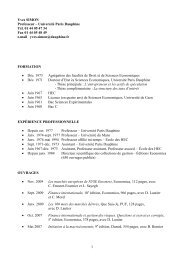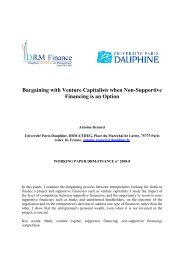Souad AJILI - CEREG - Université Paris-Dauphine
Souad AJILI - CEREG - Université Paris-Dauphine
Souad AJILI - CEREG - Université Paris-Dauphine
Create successful ePaper yourself
Turn your PDF publications into a flip-book with our unique Google optimized e-Paper software.
The Cross-Section Returns in France: Characteristics or Covariances<br />
Like Fama and French (1993), table 5 shows that HML portfolio returns have<br />
negative correlation with excess market and SMB portfolio returns (-0.015 and -<br />
0.243 respectively). Unlike Fama and French (1993), SMB and market portfolio<br />
have negative correlation. Molay (1999) documented that this negative correlation<br />
between SMB portfolio and market portfolio can be explained by the fact that<br />
market portfolio is value weighted. When we consider an equal weighted portfolio,<br />
this correlation become positive (and it is about 0.165 for our sample and 0.13 in<br />
Molay’s study) 16 .<br />
On the basis of the adjusted R 2 criterion, we can affirm that the three factor model<br />
captures common variation in stock returns 17 . Indeed, for the eight portfolios, we<br />
obtained an average adjusted R 2 about 90.5%. Our results are better than these<br />
of Molay (2001) who obtained an average adjusted R 2 of 82.0% with the three<br />
factor model 18 . The market βs are all more than 31 standard errors from zero and<br />
adjusted R 2 ranges from 82.1% to 95.3%. Moreover, HML slopes are related to book<br />
to market ratio. For, as big as small, capitalisations; they increase from negative<br />
values for the lowest book to market quintile to positive values for the highest book<br />
to market quintile. Their t-statistics are greater than three. Similarly, SMB slopes<br />
are related to size. In every book to market quintile, they decrease from small to<br />
big capitalisation. They are more than three standard errors from zero.<br />
Fama and French (1993) argue that the multi-factor asset pricing models of Merton<br />
(1973) and Ross (1976) imply a simple test of whether the set of explanatory<br />
variables suffice to describe the cross-section of average returns: intercepts of timeseries<br />
regressions should be close to zero. In all cases, intercepts are below two<br />
standard errors from zero 19 . To sum up our results, we can say that the regressions<br />
of the three factor model absorb common time-series variation in returns (slopes and<br />
adjusted R 2 values). Moreover, because of intercepts which are close to zero, they<br />
explain the cross-section of average returns.<br />
3. Size, Book to Market and HML Factor Loadings Sorted Portfolios<br />
3.1. Database and Methodology. Like Daniel and Titman, we use ex-ante observable<br />
information to estimate expected future HML factor loading of stocks. We<br />
regress each stock’s returns on the three factor portfolios (Market, HML and SMB)<br />
for the period -42 to -7 relative to the portfolio formation date. Both Daniel and<br />
Titman (1997) and Davis et al. (2000), use special factor portfolios to calculate the<br />
preformation factor loadings. They consider constant weights of June of year t to<br />
returns from date -42 to -7. However, Davis et al. (2000) report that using the<br />
variable-weight factors to estimate preformation risk loadings has little effect on the<br />
16 The appendix shows the monthly excess returns of the three explanatory variables for the<br />
period from July 1976 to June 2001.<br />
17 For further results on the comparaison between the three factor model and the CAPM, see<br />
Ajili (2002).<br />
18 Molay (1999) obtained an average adjusted R 2 of 79.7% with the three factor model<br />
19 Molay (1999)and Molay (2001), obtained two regressions of the three factor model out of<br />
nine where intercepts are more than two standard errors from zero.<br />
13



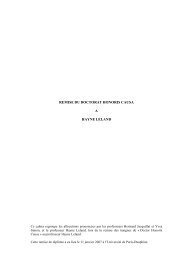

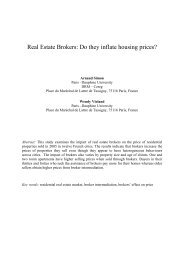
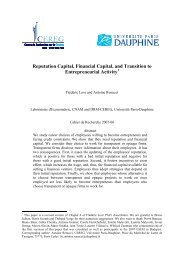

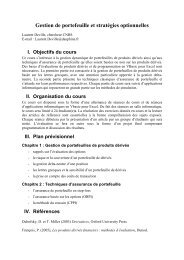

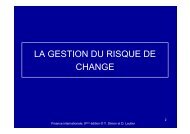
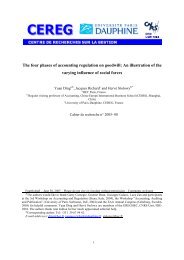
![& 6 ] ^ F ]^ - CEREG - Université Paris-Dauphine](https://img.yumpu.com/33326502/1/184x260/-6-f-cereg-universitac-paris-dauphine.jpg?quality=85)

